Bibliometric Analysis of Research on Exercise Intervention for Cancer-Related Cognitive Impairments
Abstract
1. Introduction
2. Materials and Methods
2.1. Data Source and Literature Search Strategy
2.2. Statistical Analysis
3. Results
3.1. Overall Publication Status
3.2. Analysis of Countries and Source Journals
3.2.1. Analysis of Highly Productive Countries
3.2.2. Analysis of Highly Productive Journals
3.3. Author and Institution Analysis
3.3.1. Author Productivity through Lotka’s Law
3.3.2. Analysis of Highly Productive Institutions
3.4. Citation Analysis of Papers
3.5. Keyword Analysis
3.5.1. Keyword Frequency Distribution
3.5.2. Trend Analysis of Keyword Hotspots over the Years
3.5.3. Thematic Map
4. Discussion
4.1. General Research Directions
4.2. Hotspots and Frontiers
4.3. Existing Limitations
5. Conclusions
Author Contributions
Funding
Institutional Review Board Statement
Informed Consent Statement
Data Availability Statement
Conflicts of Interest
References
- Sung, H.; Ferlay, J.; Siegel, R.L.; Laversanne, M.; Soerjomataram, I.; Jemal, A.; Bray, F. Global Cancer Statistics 2020: GLOBOCAN Estimates of Incidence and Mortality Worldwide for 36 Cancers in 185 Countries. CA A Cancer J. Clin. 2021, 71, 209–249. [Google Scholar] [CrossRef] [PubMed]
- Quaresma, M.; Coleman, M.P.; Rachet, B. 40-Year Trends in an Index of Survival for All Cancers Combined and Survival Adjusted for Age and Sex for Each Cancer in England and Wales, 1971–2011: A Population-Based Study. Lancet 2015, 385, 1206–1218. [Google Scholar] [CrossRef] [PubMed]
- Pearce, A.; Haas, M.; Viney, R.; Pearson, S.-A.; Haywood, P.; Brown, C.; Ward, R. Incidence and Severity of Self-Reported Chemotherapy Side Effects in Routine Care: A Prospective Cohort Study. PLoS ONE 2017, 12, e0184360. [Google Scholar] [CrossRef] [PubMed]
- Lindner, O.C.; Phillips, B.; McCabe, M.G.; Mayes, A.; Wearden, A.; Varese, F.; Talmi, D. A Meta-Analysis of Cognitive Impairment Following Adult Cancer Chemotherapy. Neuropsychology 2014, 28, 726–740. [Google Scholar] [CrossRef]
- Schagen, S.B.; Wefel, J.S. Chemotherapy-Related Changes in Cognitive Functioning. Eur. J. Cancer Suppl. 2013, 11, 225–232. [Google Scholar] [CrossRef]
- Whittaker, A.L.; George, R.P.; O’Malley, L. Prevalence of Cognitive Impairment Following Chemotherapy Treatment for Breast Cancer: A Systematic Review and Meta-Analysis. Sci. Rep. 2022, 12, 2135. [Google Scholar] [CrossRef] [PubMed]
- Karschnia, P.; Parsons, M.W.; Dietrich, J. Pharmacologic Management of Cognitive Impairment Induced by Cancer Therapy. Lancet Oncol. 2019, 20, e92–e102. [Google Scholar] [CrossRef]
- Mackenzie, L.; Marshall, K. Effective Non-Pharmacological Interventions for Cancer Related Cognitive Impairment in Adults (Excluding Central Nervous System or Head and Neck Cancer): Systematic Review and Meta-Analysis. Eur. J. Phys. Rehabil. Med. 2022, 58, 258–270. [Google Scholar] [CrossRef]
- Liu, Y.; Liu, J.-E.; Chen, S.; Zhao, F.; Chen, L.; Li, R. Effectiveness of Nonpharmacologic Interventions for Chemotherapy-Related Cognitive Impairment in Breast Cancer Patients: A Systematic Review and Network Meta-Analysis. Cancer Nurs. 2023, 46, E305–E319. [Google Scholar] [CrossRef]
- Scott, J.M.; Zabor, E.C.; Schwitzer, E.; Koelwyn, G.J.; Adams, S.C.; Nilsen, T.S.; Moskowitz, C.S.; Matsoukas, K.; Iyengar, N.M.; Dang, C.T.; et al. Efficacy of Exercise Therapy on Cardiorespiratory Fitness in Patients With Cancer: A Systematic Review and Meta-Analysis. J. Clin. Oncol. 2018, 36, 2297–2305. [Google Scholar] [CrossRef]
- Bjørke, A.C.H.; Sweegers, M.G.; Buffart, L.M.; Raastad, T.; Nygren, P.; Berntsen, S. Which Exercise Prescriptions Optimize VO2 Max during Cancer Treatment?—A Systematic Review and Meta-Analysis. Scand. J. Med. Sci. Sports 2019, 29, 1274–1287. [Google Scholar] [CrossRef] [PubMed]
- Lopez, P.; Taaffe, D.R.; Newton, R.U.; Galvão, D.A. Resistance Exercise Dosage in Men with Prostate Cancer: Systematic Review, Meta-Analysis, and Meta-Regression. Med. Sci. Sports Exerc. 2021, 53, 459–469. [Google Scholar] [CrossRef] [PubMed]
- Abo, S.; Denehy, L.; Ritchie, D.; Lin, K.-Y.; Edbrooke, L.; McDonald, C.; Granger, C.L. People With Hematological Malignancies Treated With Bone Marrow Transplantation Have Improved Function, Quality of Life, and Fatigue Following Exercise Intervention: A Systematic Review and Meta-Analysis. Phys. Ther. 2021, 101, pzab130. [Google Scholar] [CrossRef] [PubMed]
- Oberoi, S.; Robinson, P.D.; Cataudella, D.; Culos-Reed, S.N.; Davis, H.; Duong, N.; Gibson, F.; Götte, M.; Hinds, P.; Nijhof, S.L.; et al. Physical Activity Reduces Fatigue in Patients with Cancer and Hematopoietic Stem Cell Transplant Recipients: A Systematic Review and Meta-Analysis of Randomized Trials. Crit. Rev. Oncol. Hematol. 2018, 122, 52–59. [Google Scholar] [CrossRef]
- Hilfiker, R.; Meichtry, A.; Eicher, M.; Nilsson Balfe, L.; Knols, R.H.; Verra, M.L.; Taeymans, J. Exercise and Other Non-Pharmaceutical Interventions for Cancer-Related Fatigue in Patients during or after Cancer Treatment: A Systematic Review Incorporating an Indirect-Comparisons Meta-Analysis. Br. J. Sports Med. 2018, 52, 651–658. [Google Scholar] [CrossRef]
- Bruce, J.; Mazuquin, B.; Canaway, A.; Hossain, A.; Williamson, E.; Mistry, P.; Lall, R.; Petrou, S.; Lamb, S.E.; Rees, S.; et al. Exercise versus Usual Care after Non-Reconstructive Breast Cancer Surgery (UK PROSPER): Multicentre Randomised Controlled Trial and Economic Evaluation. BMJ 2021, 375, e066542. [Google Scholar] [CrossRef]
- Cuthbert, C.; Twomey, R.; Bansal, M.; Rana, B.; Dhruva, T.; Livingston, V.; Daun, J.T.; Culos-Reed, S.N. The Role of Exercise for Pain Management in Adults Living with and beyond Cancer: A Systematic Review and Meta-Analysis. Support. Care Cancer 2023, 31, 254–279. [Google Scholar] [CrossRef] [PubMed]
- Streckmann, F.; Balke, M.; Cavaletti, G.; Toscanelli, A.; Bloch, W.; Décard, B.F.; Lehmann, H.C.; Faude, O. Exercise and Neuropathy: Systematic Review with Meta-Analysis. Sports Med. 2022, 52, 1043–1065. [Google Scholar] [CrossRef]
- Nuñez de Arenas-Arroyo, S.; Cavero-Redondo, I.; Torres-Costoso, A.; Reina-Gutiérrez, S.; Lorenzo-García, P.; Martínez-Vizcaíno, V. Effects of Exercise Interventions to Reduce Chemotherapy-Induced Peripheral Neuropathy Severity: A Meta-Analysis. Scand. J. Med. Sci. Sports 2023, 33, 1040–1053. [Google Scholar] [CrossRef]
- Singh, B.; Hayes, S.C.; Spence, R.R.; Steele, M.L.; Millet, G.Y.; Gergele, L. Exercise and Colorectal Cancer: A Systematic Review and Meta-Analysis of Exercise Safety, Feasibility and Effectiveness. Int. J. Behav. Nutr. Phys. Act. 2020, 17, 122–136. [Google Scholar] [CrossRef]
- Singh, B.; Spence, R.R.; Steele, M.L.; Sandler, C.X.; Peake, J.M.; Hayes, S.C. A Systematic Review and Meta-Analysis of the Safety, Feasibility, and Effect of Exercise in Women With Stage II+ Breast Cancer. Arch. Phys. Med. Rehabil. 2018, 99, 2621–2636. [Google Scholar] [CrossRef] [PubMed]
- Donthu, N.; Kumar, S.; Mukherjee, D.; Pandey, N.; Lim, W.M. How to Conduct a Bibliometric Analysis: An Overview and Guidelines. J. Bus. Res. 2021, 133, 285–296. [Google Scholar] [CrossRef]
- Dong, Y.; Li, D. Gender Representation in Textbooks: A Bibliometric Study. Scientometrics 2023, 128, 5969–6001. [Google Scholar] [CrossRef]
- Haunschild, R.; Bornmann, L. Identification of Potential Young Talented Individuals in the Natural and Life Sciences: A Bibliometric Approach. J. Informetr. 2023, 17, 101394. [Google Scholar] [CrossRef]
- Weimer, V.; Heck, T.; van Leeuwen, T.; Rittberger, M. The Quantification of Open Scholarship—A Mapping Review. Quant. Sci. Stud. 2023, 4, 650–670. [Google Scholar] [CrossRef]
- Pedraja-Rejas, L.; Garrido-Tamayo, M.-A.; Ortega-Piwonka, I.; Rodríguez-Ponce, E.; Laroze, D. Scientific Production in Latin American Physics: A Bibliometric Analysis. Scientometrics 2024, 129, 4189–4230. [Google Scholar] [CrossRef]
- Song, Y.; Chen, X.; Hao, T.; Liu, Z.; Lan, Z. Exploring Two Decades of Research on Classroom Dialogue by Using Bibliometric Analysis. Comput. Educ. 2019, 137, 12–31. [Google Scholar] [CrossRef]
- Web of Science Platform. Available online: https://clarivate.com/products/scientific-and-academic-research/research-discovery-and-workflow-solutions/webofscience-platform/ (accessed on 6 August 2024).
- Gerasimov, I.; KC, B.; Mehrabian, A.; Acker, J.; McGuire, M.P. Comparison of Datasets Citation Coverage in Google Scholar, Web of Science, Scopus, Crossref, and DataCite. Scientometrics 2024, 129, 3681–3704. [Google Scholar] [CrossRef]
- Liu, W. The Data Source of This Study Is Web of Science Core Collection? Not Enough. Scientometrics 2019, 121, 1815–1824. [Google Scholar] [CrossRef]
- Ihaka, R.; Gentleman, R. R: A Language for Data Analysis and Graphics. J. Comput. Graph. Stat. 1996, 5, 299–314. [Google Scholar] [CrossRef]
- Bibliometrix: An R-Tool for Comprehensive Science Mapping Analysis. J. Informetr. 2017, 11, 959–975. [CrossRef]
- Strang, P. Cancer Pain—A Provoker of Emotional, Social and Existential Distress. Acta Oncol. 1998, 37, 641–644. [Google Scholar] [CrossRef] [PubMed]
- Liu, F. Retrieval Strategy and Possible Explanations for the Abnormal Growth of Research Publications: Re-Evaluating a Bibliometric Analysis of Climate Change. Scientometrics 2023, 128, 853–859. [Google Scholar] [CrossRef] [PubMed]
- Coile, R.C. Lotka’s frequency distribution of scientific productivity. J. Am. Soc. Inf. Sci. 1977, 28, 366–370. [Google Scholar] [CrossRef]
- Courneya, K.S.; Segal, R.J.; Mackey, J.R.; Gelmon, K.; Reid, R.D.; Friedenreich, C.M.; Ladha, A.B.; Proulx, C.; Vallance, J.K.H.; Lane, K.; et al. Effects of Aerobic and Resistance Exercise in Breast Cancer Patients Receiving Adjuvant Chemotherapy: A Multicenter Randomized Controlled Trial. J. Clin. Oncol. 2007, 25, 4396–4404. [Google Scholar] [CrossRef]
- Yang, Z.; Hotterbeex, P.; Marent, P.-J.; Cerin, E.; Thomis, M.; van Uffelen, J. Physical Activity, Sedentary Behaviour, and Cognitive Function among Older Adults: A Bibliometric Analysis from 2004 to 2024. Ageing Res. Rev. 2024, 97, 102283. [Google Scholar] [CrossRef]
- Dos Santos, M.; Ferrari, G.; Lee, D.H.; Rey-López, J.P.; Aune, D.; Liao, B.; Huang, W.; Nie, J.; Wang, Y.; Giovannucci, E.; et al. Association of the “Weekend Warrior” and Other Leisure-Time Physical Activity Patterns With All-Cause and Cause-Specific Mortality: A Nationwide Cohort Study. JAMA Intern. Med. 2022, 182, 840–848. [Google Scholar] [CrossRef]
- Zhu, C.; Ma, H.; He, A.; Li, Y.; He, C.; Xia, Y. Exercise in Cancer Prevention and Anticancer Therapy: Efficacy, Molecular Mechanisms and Clinical Information. Cancer Lett. 2022, 544, 215814. [Google Scholar] [CrossRef]
- Schauer, T.; Mazzoni, A.-S.; Henriksson, A.; Demmelmaier, I.; Berntsen, S.; Raastad, T.; Nordin, K.; Pedersen, B.K.; Christensen, J.F. Exercise Intensity and Markers of Inflammation during and after (Neo-) Adjuvant Cancer Treatment. Endocr. Relat. Cancer 2021, 28, 191–201. [Google Scholar] [CrossRef]
- Gubert, C.; Hannan, A.J. Exercise Mimetics: Harnessing the Therapeutic Effects of Physical Activity. Nat. Rev. Drug. Discov. 2021, 20, 862–879. [Google Scholar] [CrossRef]
- Matthews, H.K.; Bertoli, C.; de Bruin, R.A.M. Cell Cycle Control in Cancer. Nat. Rev. Mol. Cell Biol. 2022, 23, 74–88. [Google Scholar] [CrossRef] [PubMed]
- Emery, J.; Butow, P.; Lai-Kwon, J.; Nekhlyudov, L.; Rynderman, M.; Jefford, M. Management of Common Clinical Problems Experienced by Survivors of Cancer. Lancet 2022, 399, 1537–1550. [Google Scholar] [CrossRef]
- Schofield, C.; Newton, R.U.; Taaffe, D.R.; Galvão, D.A.; Cohen, P.A.; Meniawy, T.M.; Peddle-McIntyre, C.J. Supervised Resistance Exercise for Women with Ovarian Cancer Who Have Completed First-Line Treatment: A Pragmatic Study. Support. Care Cancer 2023, 31, 304. [Google Scholar] [CrossRef] [PubMed]
- Piché, A.; Santa Mina, D.; Lambert, S.; Doré, I. Assessing Real-World Implementability of a Multimodal Group-Based Tele-Prehabilitation Program in Cancer Care: A Pragmatic Feasibility Study. Front. Oncol. 2023, 13, 1271812. [Google Scholar] [CrossRef]
- Franco-Rocha, O.Y.; Mahaffey, M.L.; Matsui, W.; Kesler, S.R. Remote Assessment of Cognitive Dysfunction in Hematologic Malignancies Using Web-Based Neuropsychological Testing. Cancer Med. 2023, 12, 6068–6076. [Google Scholar] [CrossRef]
- Root, J.C.; Gaynor, A.M.; Ahsan, A.; Jung, D.; Schofield, E.; Ryan, E.; Li, Y.; Ahles, T.A. Remote, Computerised Cognitive Assessment for Breast Cancer- and Treatment-Related Cognitive Dysfunction: Psychometric Characteristics of the Cogsuite Neurocognitive Battery. Arch. Clin. Neuropsychol. 2023, 38, 699–713. [Google Scholar] [CrossRef] [PubMed]
- Fiuza-Luces, C.; Valenzuela, P.L.; Santos-Lozano, A.; Ruiz-Casado, A.; Lucia, A. Exercise and Quality of Life in Cancer. J. Sport Health Sci. 2023, 12, 489–490. [Google Scholar] [CrossRef]
- Martínez-Vizcaíno, V.; Cavero-Redondo, I.; Reina-Gutiérrez, S.; Gracia-Marco, L.; Gil-Cosano, J.J.; Bizzozero-Peroni, B.; Rodriguez-Artalejo, F.; Ubago-Guisado, E. Comparative Effects of Different Types of Exercise on Health-Related Quality of Life during and after Active Cancer Treatment: A Systematic Review and Network Meta-Analysis. J. Sport. Health Sci. 2023, 12, 726–738. [Google Scholar] [CrossRef]
- Campbell, K.L.; Zadravec, K.; Bland, K.A.; Chesley, E.; Wolf, F.; Janelsins, M.C. The Effect of Exercise on Cancer-Related Cognitive Impairment and Applications for Physical Therapy: Systematic Review of Randomized Controlled Trials. Phys. Ther. 2020, 100, 523–542. [Google Scholar] [CrossRef]
- Brunet, J.; Sharma, S. A Scoping Review of Studies Exploring Physical Activity and Cognition among Persons with Cancer. J. Cancer Surviv. 2023; ahead of print. [Google Scholar] [CrossRef]
- Rock, C.L.; Thomson, C.A.; Sullivan, K.R.; Howe, C.L.; Kushi, L.H.; Caan, B.J.; Neuhouser, M.L.; Bandera, E.V.; Wang, Y.; Robien, K.; et al. American Cancer Society Nutrition and Physical Activity Guideline for Cancer Survivors. CA A Cancer J. Clin. 2022, 72, 230–262. [Google Scholar] [CrossRef]
- Kenfield, S.A.; Chan, J.M. Meeting Exercise Recommendations Is Beneficial for Cancer Survivors. J. Clin. Oncol. 2023, 41, 4965–4967. [Google Scholar] [CrossRef] [PubMed]
- Campbell, K.L.; Winters-Stone, K.M.; Wiskemann, J.; May, A.M.; Schwartz, A.L.; Courneya, K.S.; Zucker, D.S.; Matthews, C.E.; Ligibel, J.A.; Gerber, L.H.; et al. Exercise Guidelines for Cancer Survivors: Consensus Statement from International Multidisciplinary Roundtable. Med. Sci. Sports Exerc. 2019, 51, 2375–2390. [Google Scholar] [CrossRef]
- Lange, M.; Joly, F.; Vardy, J.; Ahles, T.; Dubois, M.; Tron, L.; Winocur, G.; De Ruiter, M.B.; Castel, H. Cancer-Related Cognitive Impairment: An Update on State of the Art, Detection, and Management Strategies in Cancer Survivors. Ann. Oncol. 2019, 30, 1925–1940. [Google Scholar] [CrossRef] [PubMed]
- Bernal, J.D.K.; Recchia, F.; Yu, D.J.; Fong, D.Y.; Wong, S.H.S.; Chung, P.-K.; Chan, D.K.C.; Capio, C.M.; Yu, C.C.W.; Wong, S.W.S.; et al. Physical Activity and Exercise for Cancer-Related Cognitive Impairment among Individuals Affected by Childhood Cancer: A Systematic Review and Meta-Analysis. Lancet Child Adolesc. Health 2023, 7, 47–58. [Google Scholar] [CrossRef] [PubMed]
- Northey, J.M.; Pumpa, K.L.; Quinlan, A.C.; Ikin, A.; Toohey, K.; Smee, D.J.; Rattray, B. Cognition in Breast Cancer Survivors: A Pilot Study of Interval and Continuous Exercise. J. Sci. Med. Sport 2019, 22, 580–585. [Google Scholar] [CrossRef]
- Akbari, P.S.; Hassan, Y.; Archibald, L.; Tajik, T.; Dunn, K.; Berris, M.; Smith-Turchyn, J. Effect of Physical Activity During Chemotherapy on Cognitive Function in Cancer Survivors: A Systematic Review and Meta-Analysis. Physiother. Can. 2023, 75, 12–21. [Google Scholar] [CrossRef]
- Hiensch, A.E.; Beckhaus, J.; Witlox, L.; Monninkhof, E.M.; Schagen, S.B.; van Vulpen, J.K.; Sweegers, M.G.; Newton, R.U.; Aaronson, N.K.; Galvão, D.A.; et al. Moderators of Exercise Effects on Self-Reported Cognitive Functioning in Cancer Survivors: An Individual Participant Data Meta-Analysis. J. Cancer Surviv. 2023, 18, 1492–1503. [Google Scholar] [CrossRef]
- Andersen, B.L.; Lacchetti, C.; Ashing, K.; Berek, J.S.; Berman, B.S.; Bolte, S.; Dizon, D.S.; Given, B.; Nekhlyudov, L.; Pirl, W.; et al. Management of Anxiety and Depression in Adult Survivors of Cancer: ASCO Guideline Update. J. Clin. Oncol. 2023, 41, 3426–3453. [Google Scholar] [CrossRef]
- Liu, M.G.; Davis, G.M.; Kilbreath, S.L.; Yee, J. Physical Activity Interventions Using Behaviour Change Theories for Women with Breast Cancer: A Systematic Review and Meta-Analysis. J. Cancer Surviv. 2022, 16, 1127–1148. [Google Scholar] [CrossRef]
- Rodrigues, B.; Carraça, E.V.; Francisco, B.B.; Nobre, I.; Cortez-Pinto, H.; Santos, I. Theory-Based Physical Activity and/or Nutrition Behavior Change Interventions for Cancer Survivors: A Systematic Review. J. Cancer Surviv. 2023, 18, 1464–1480. [Google Scholar] [CrossRef]
- Kim, J.-S.; Galvão, D.A.; Newton, R.U.; Gray, E.; Taaffe, D.R. Exercise-Induced Myokines and Their Effect on Prostate Cancer. Nat. Rev. Urol. 2021, 18, 519–542. [Google Scholar] [CrossRef] [PubMed]
- Urlings, M.J.E.; Duyx, B.; Swaen, G.M.H.; Bouter, L.M.; Zeegers, M.P. Citation Bias and Other Determinants of Citation in Biomedical Research: Findings from Six Citation Networks. J. Clin. Epidemiol. 2021, 132, 71–78. [Google Scholar] [CrossRef] [PubMed]
- Wang, J.; Veugelers, R.; Stephan, P. Bias against Novelty in Science: A Cautionary Tale for Users of Bibliometric Indicators. Res. Policy 2017, 46, 1416–1436. [Google Scholar] [CrossRef]
- Haustein, S.; Larivière, V. The Use of Bibliometrics for Assessing Research: Possibilities, Limitations and Adverse Effects. In Incentives and Performance: Governance of Research Organizations; Welpe, I.M., Wollersheim, J., Ringelhan, S., Osterloh, M., Eds.; Springer International Publishing: Cham, Switzerland, 2015; pp. 121–139. ISBN 978-3-319-09785-5. [Google Scholar]
- Archambault, É.; Campbell, D.; Gingras, Y.; Larivière, V. Comparing Bibliometric Statistics Obtained from the Web of Science and Scopus. J. Am. Soc. Inf. Sci. Technol. 2009, 60, 1320–1326. [Google Scholar] [CrossRef]
- Jacso, P. As We May Search—Comparison of Major Features of the Web of Science, Scopus, and Google Scholar Citation-Based and Citation-Enhanced Databases. Curr. Sci. 2005, 89, 1537–1547. [Google Scholar]
- Liu, W. Caveats for the Use of Web of Science Core Collection in Old Literature Retrieval and Historical Bibliometric Analysis. Technol. Forecast. Soc. Change 2021, 172, 121023. [Google Scholar] [CrossRef]
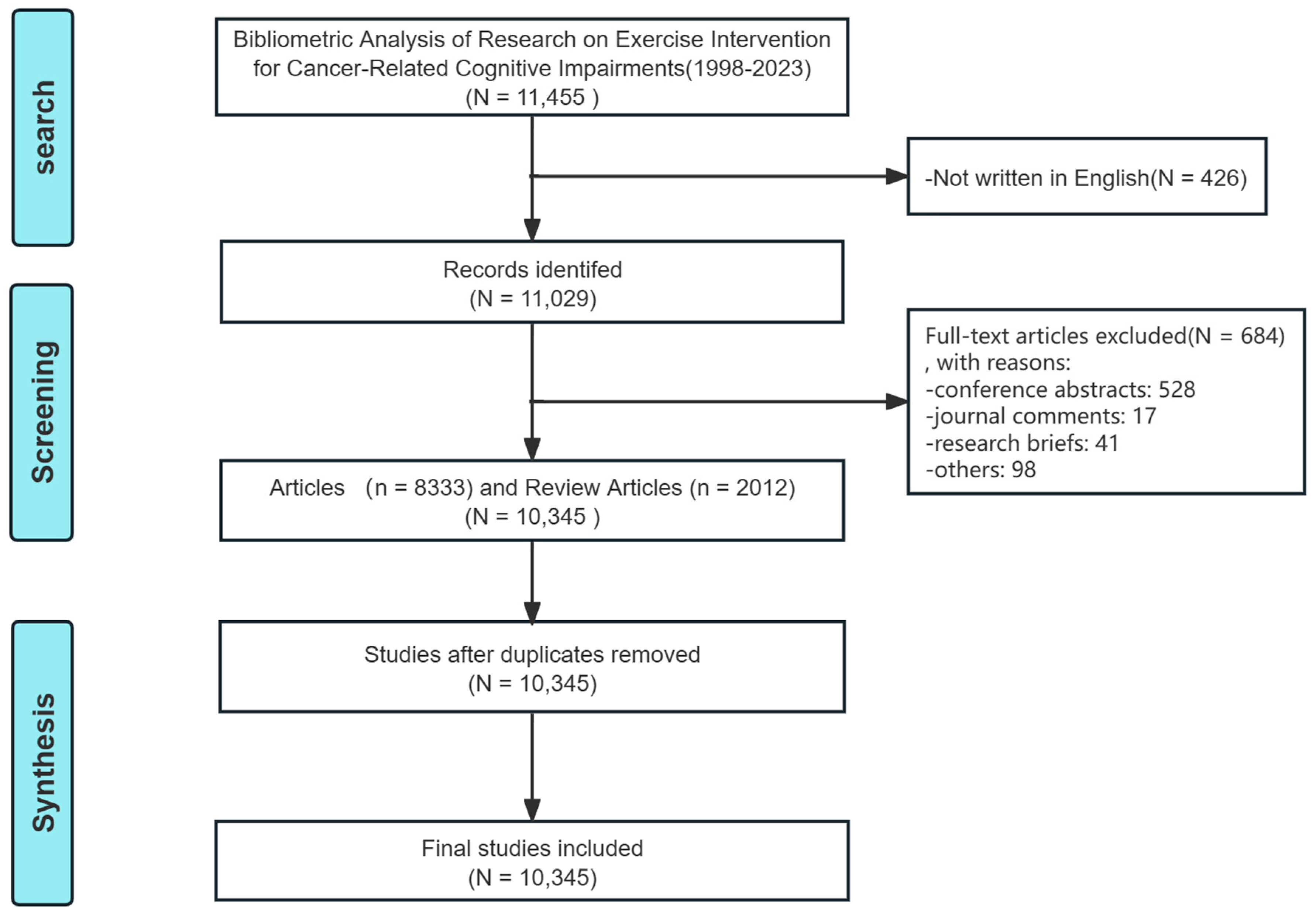
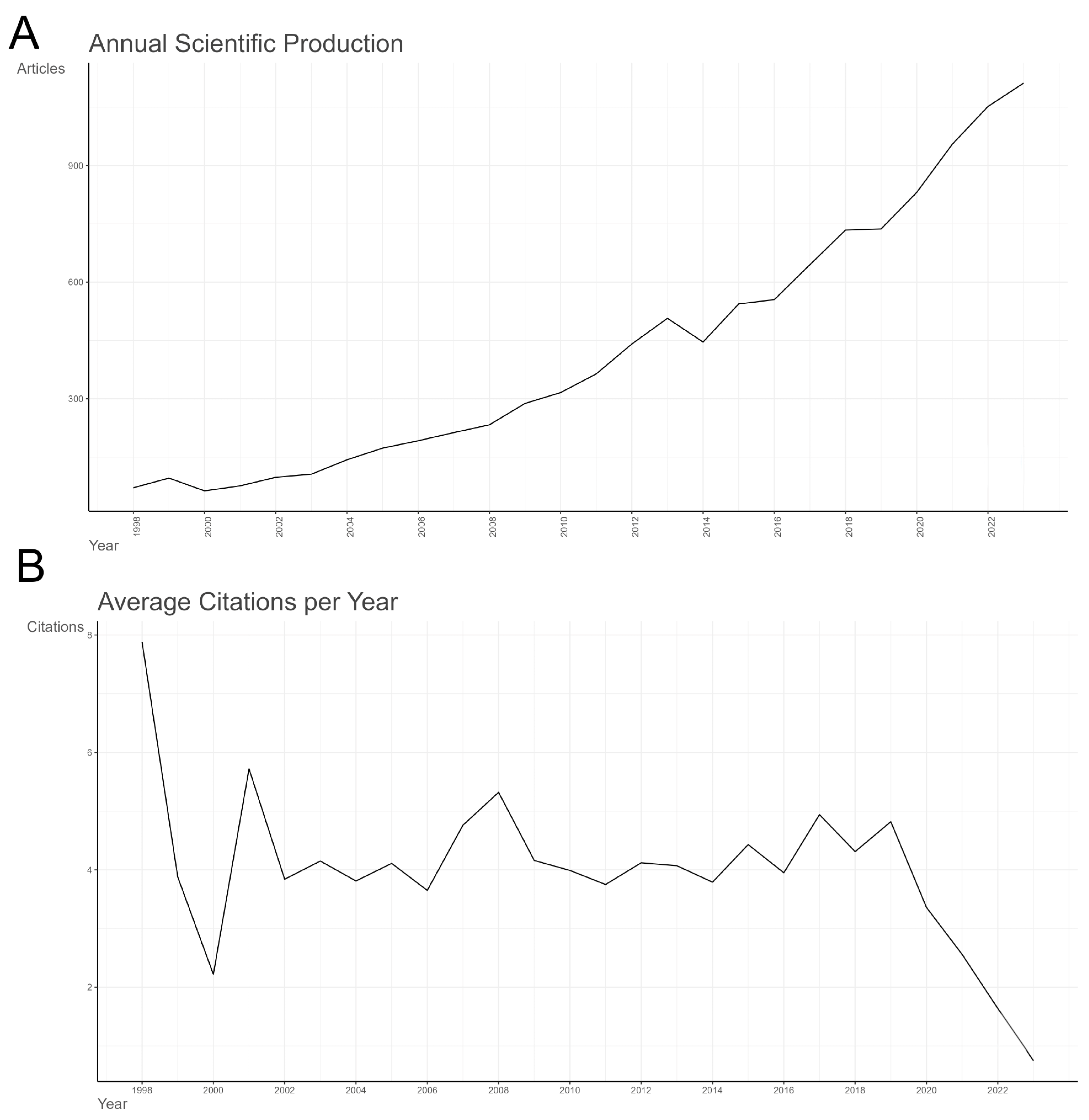
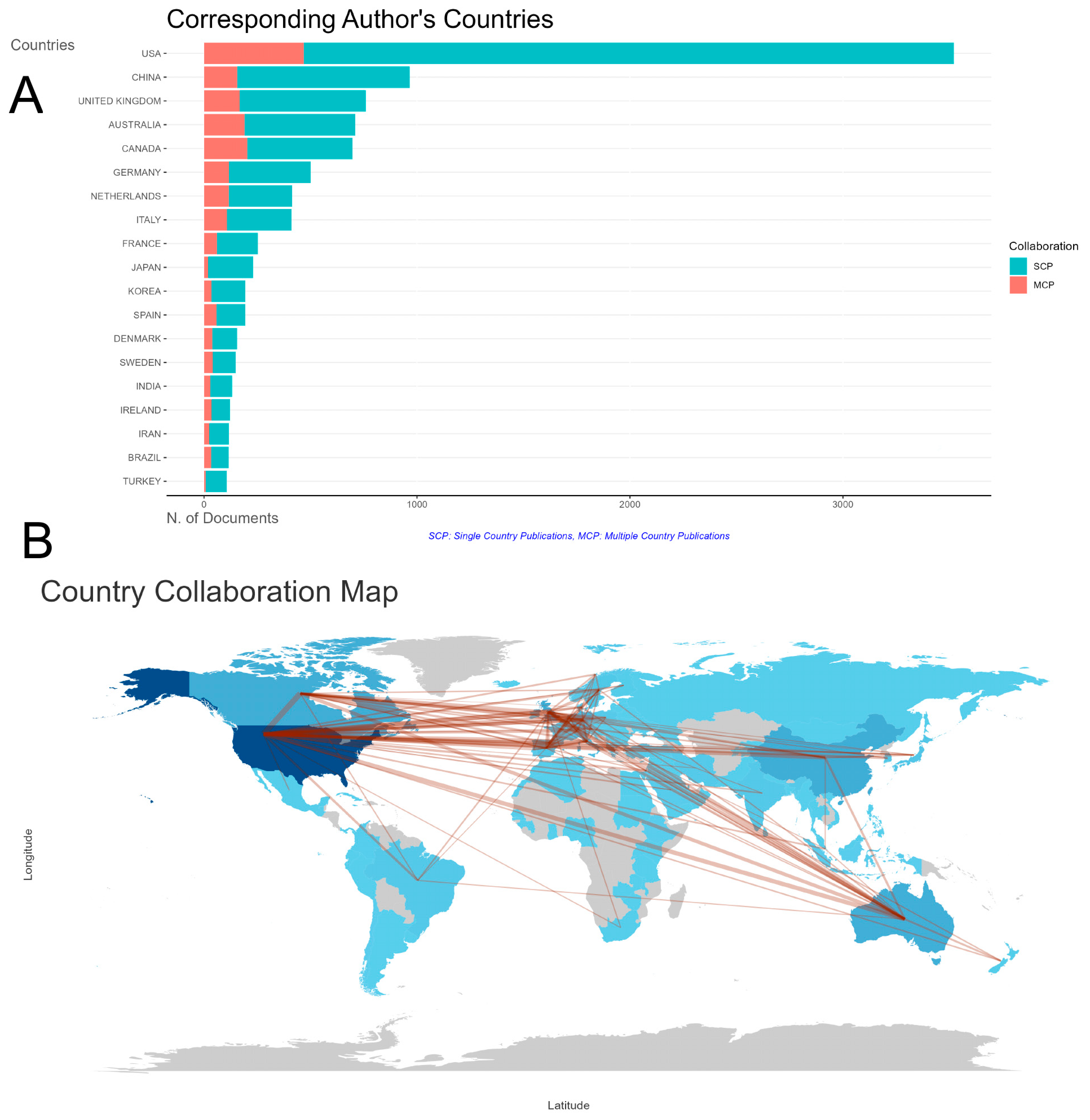
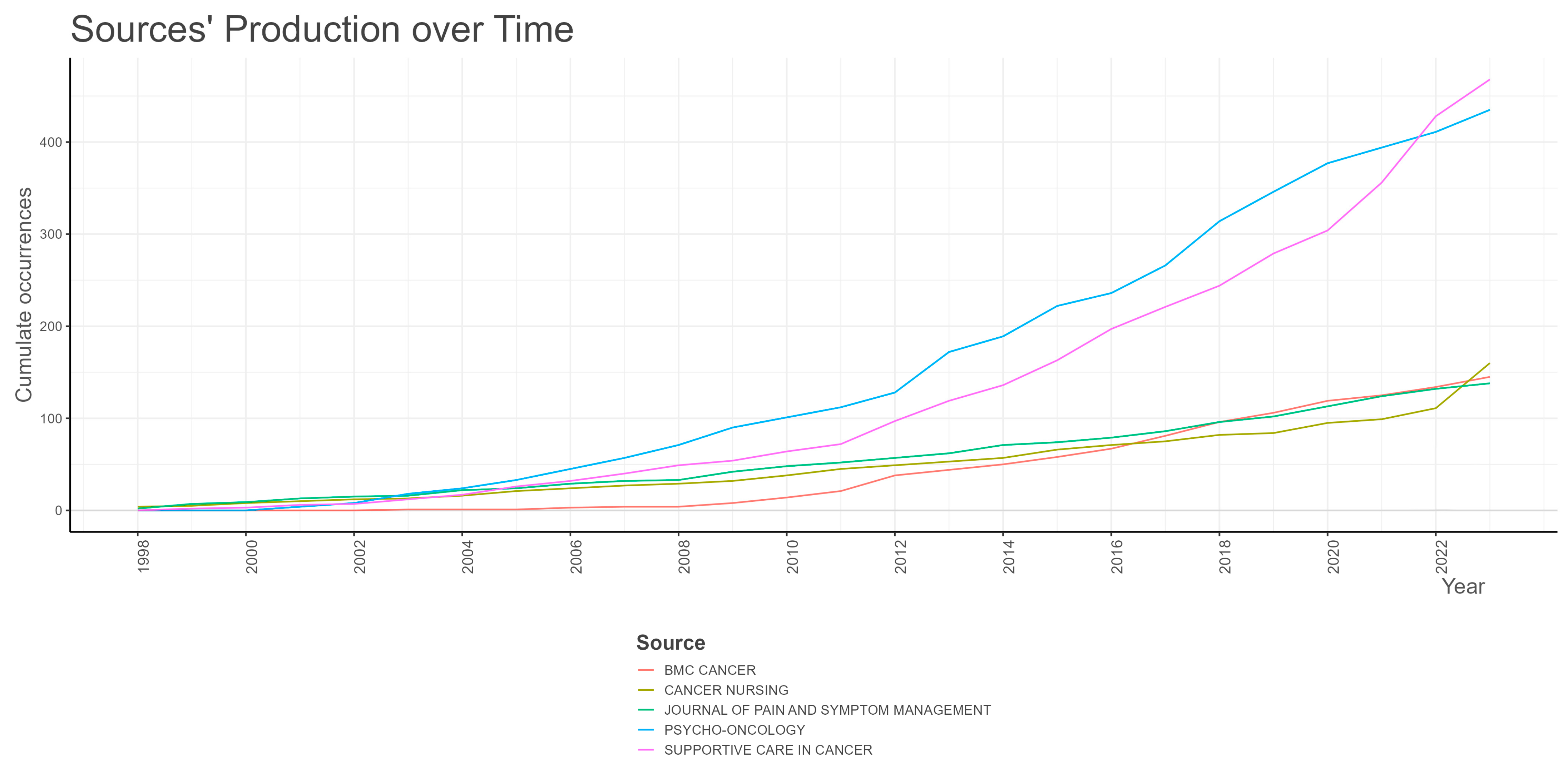
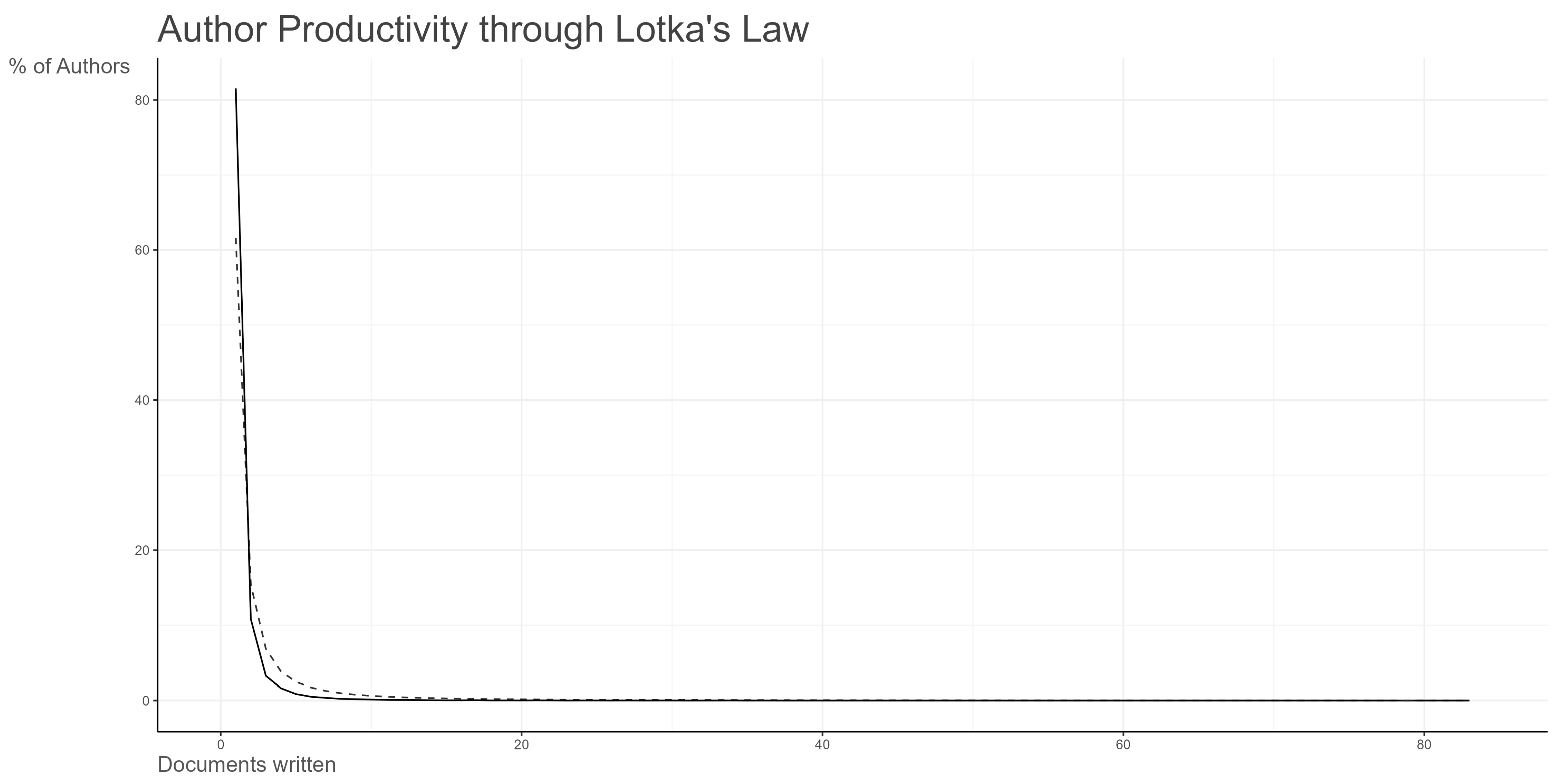
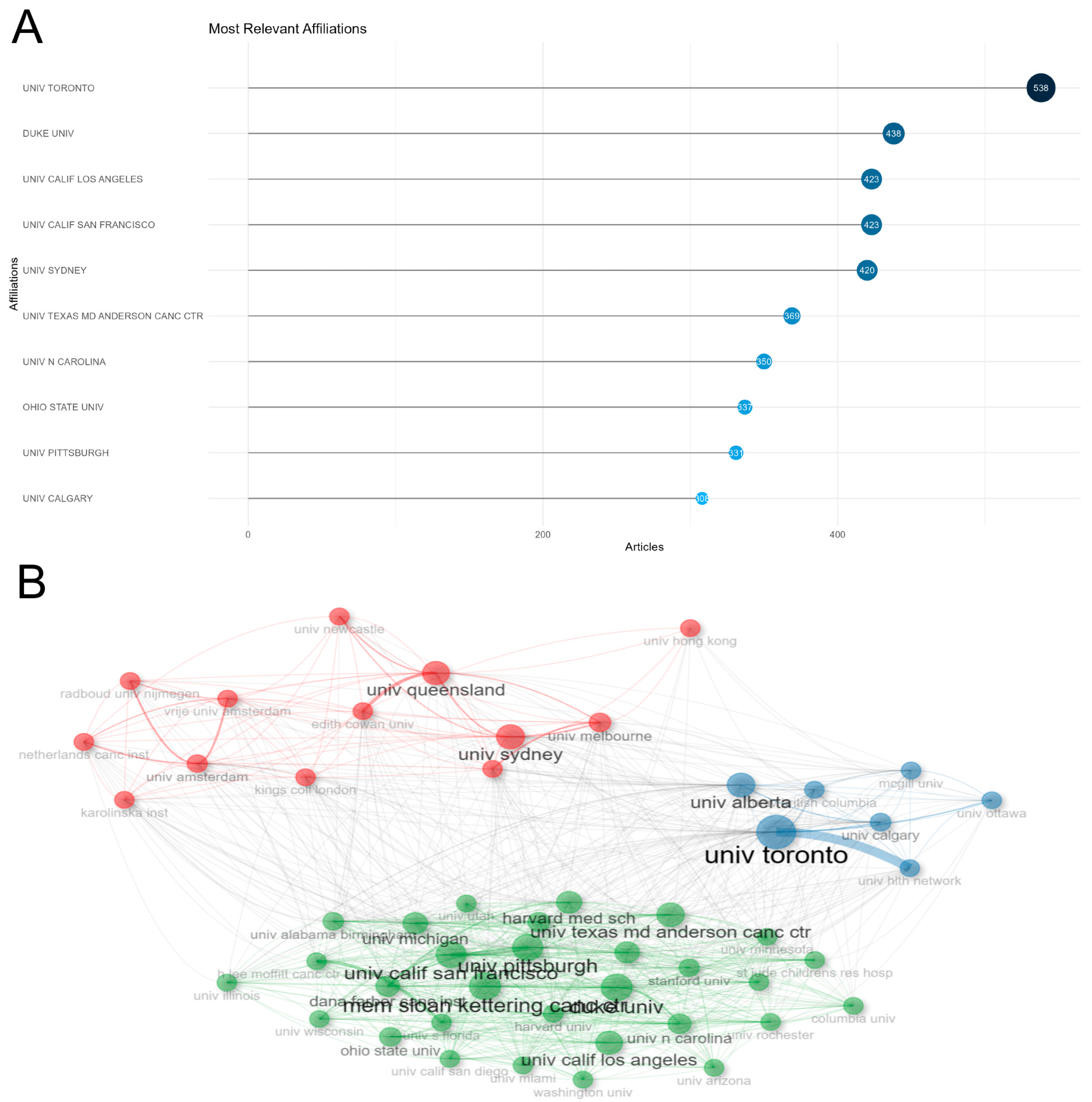
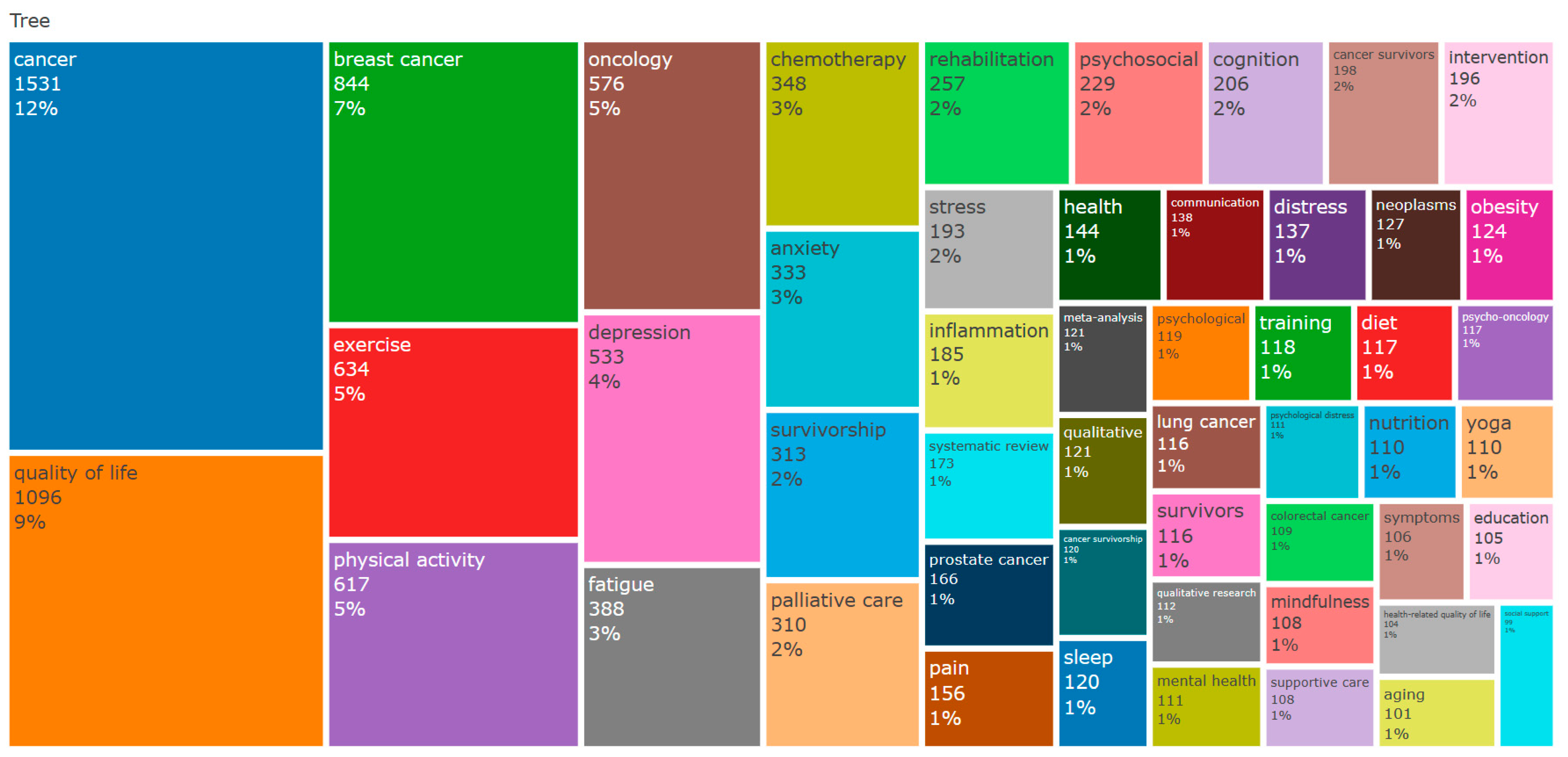
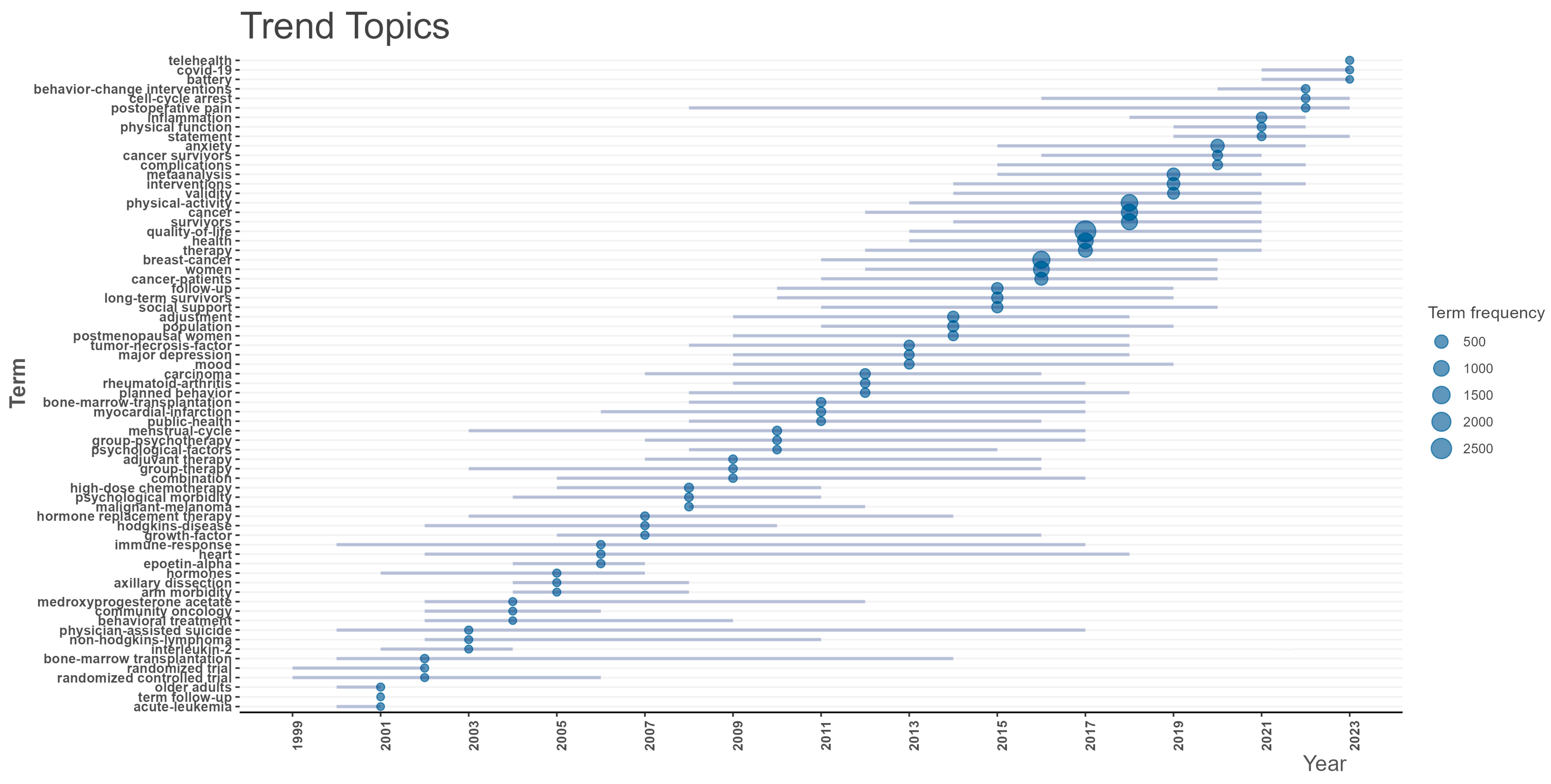
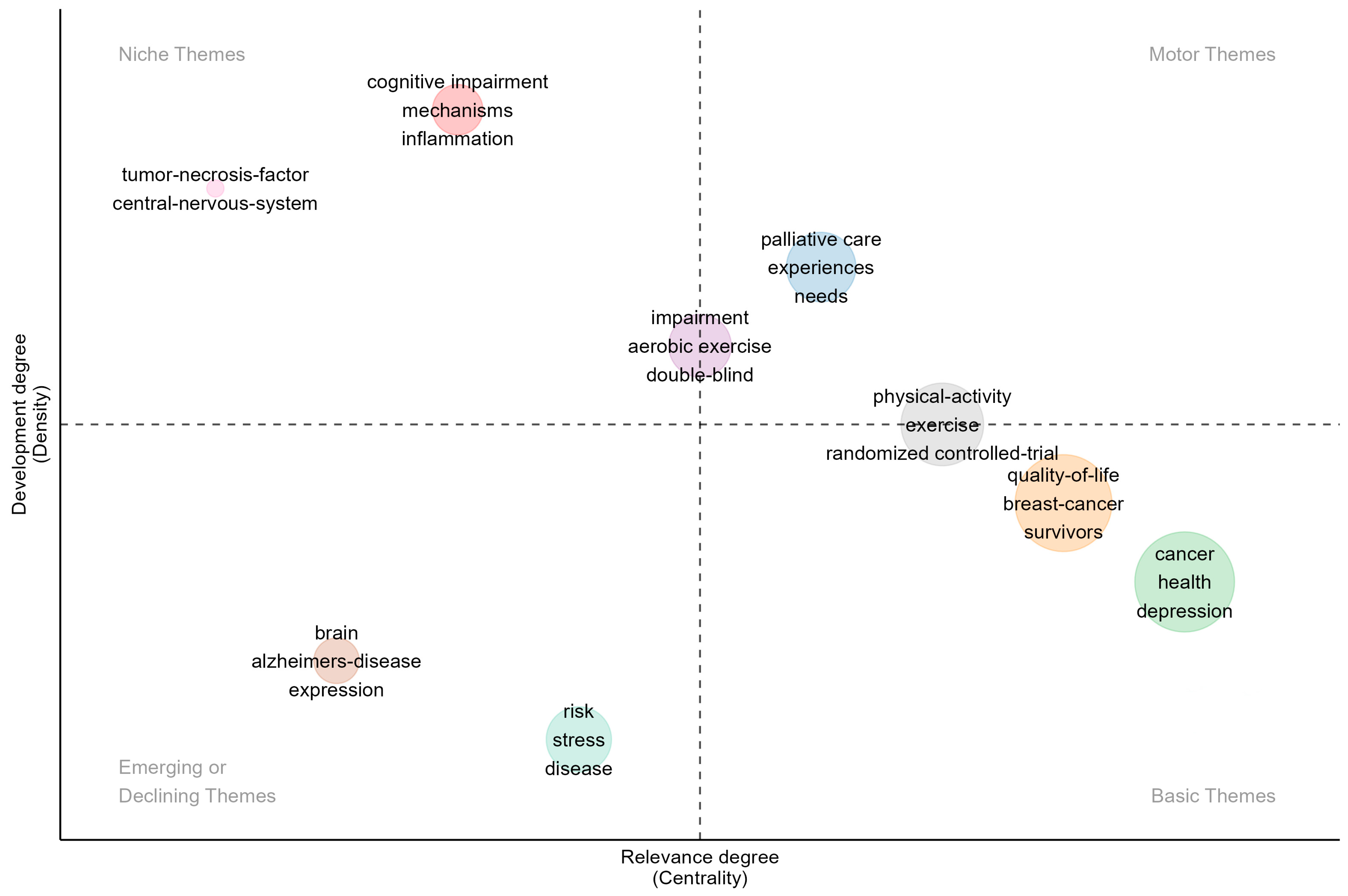
| Search Strategy | |
|---|---|
| #1 | TS = (cancer* OR tumor* OR tumour* OR Neoplasm*) |
| #2 | TS = (cogniti* OR brain*fog OR chemo*brain OR chemo*fog OR higher cerebral function OR neuropsychological OR psychologi* OR psychosocial) |
| #3 | TS = (Physical activit* OR movement* OR exercis* OR train* OR Physical fitness OR Physical conditioning OR Cardiorespiratory fitness OR Endurance OR Muscle strengthening OR Weight lifting OR Weight bearing OR Stretching OR Qigong OR Run OR Swim* OR Sport* OR Athletic* OR Jog OR walk* OR biking OR bicycling OR cycling OR Yoga OR Pilates OR Tai Ji OR Tai Chi) |
| #4 | #1 AND #2 AND #3 |
| Ranking | Country | Articles | Citations | Journal | Articles | Citations |
|---|---|---|---|---|---|---|
| 1 | United States | 3521 | 180,253 | Supportive Care in Cancer | 468 | 12,064 |
| 2 | China | 965 | 13,799 | Psycho-oncology | 435 | 14,935 |
| 3 | United Kingdom | 759 | 31,659 | Cancer Nursing | 160 | 2812 |
| 4 | Australia | 710 | 24,191 | BMC Cancer | 145 | 3691 |
| 5 | Canada | 697 | 25,926 | Journal of Pain and Symptom Management | 138 | 6520 |
| 6 | Germany | 501 | 18,796 | Cancer | 137 | 10,222 |
| 7 | The Netherlands | 414 | 16,892 | PLoS ONE | 134 | 3478 |
| 8 | Italy | 410 | 9252 | Journal of Clinical Oncology | 132 | 17,464 |
| 9 | France | 253 | 7529 | European Journal of Cancer Care | 131 | 2667 |
| 10 | Japan | 230 | 5226 | BMJ Open | 129 | 1219 |
| Ranking | Institution | Country | Articles |
|---|---|---|---|
| 1 | University of Toronto | Canada | 538 |
| 2 | Duke University | United States | 438 |
| 3 | University of California, Los Angeles | United States | 423 |
| 4 | University of California, San Francisco | United States | 423 |
| 5 | University of Sydney | Australia | 420 |
| 6 | The University of Texas MD Anderson Cancer Center | United States | 369 |
| 7 | University of North Carolina | United States | 350 |
| 8 | Ohio State University | United States | 337 |
| 9 | University of Pittsburgh | United States | 538 |
| 10 | University of Calgary | Canada | 438 |
| First Author | Year | Title | Journal | Citations |
|---|---|---|---|---|
| Kerry S Courneya | 2007 | Effects of Aerobic and Resistance Exercise in Breast Cancer Patients Receiving Adjuvant Chemotherapy: A Multicenter Randomized Controlled Trial | Journal of Clinical Oncology | 117 |
| Julienne E Bower | 2014 | Cancer-related fatigue—mechanisms, risk factors, and treatments | Nature Reviews Clinical Oncology | 107 |
| Ruud Knols | 2005 | Physical Exercise in Cancer Patients During and After Medical Treatment: A Systematic Review of Randomized and Controlled Clinical Trials | Journal of Clinical Oncology | 103 |
| Karen M Mustian | 2017 | Comparison of Pharmaceutical, Psychological, and Exercise Treatments for Cancer-Related Fatigue A Meta-analysis | JAMA Oncology | 97 |
| Daniel A Galvão | 2005 | Review of Exercise Intervention Studies in Cancer Patients | Journal of Clinical Oncology | 90 |
| Bernardine M Pinto | 2005 | Home-Based Physical Activity Intervention for Breast Cancer Patients | Journal of Clinical Oncology | 89 |
| Maarten Hofman | 2007 | Cancer-Related Fatigue: The Scale of the Problem | Oncology | 88 |
| Maria Kangas | 2008 | Cancer-related fatigue: a systematic and meta-analytic review of non-pharmacological therapies for cancer patients | Psychological Bulletin | 80 |
| Hermann Faller | 2013 | Effects of Psycho-Oncologic Interventions on Emotional Distress and Quality of Life in Adult Patients With Cancer: Systematic Review and Meta-Analysis | Journal of Clinical Oncology | 75 |
| Linda E Carlson | 2003 | Mindfulness-Based Stress Reduction in Relation to Quality of Life, Mood, Symptoms of Stress, and Immune Parameters in Breast and Prostate Cancer Outpatients | Psychosomatic Medicine | 71 |
Disclaimer/Publisher’s Note: The statements, opinions and data contained in all publications are solely those of the individual author(s) and contributor(s) and not of MDPI and/or the editor(s). MDPI and/or the editor(s) disclaim responsibility for any injury to people or property resulting from any ideas, methods, instructions or products referred to in the content. |
© 2024 by the authors. Licensee MDPI, Basel, Switzerland. This article is an open access article distributed under the terms and conditions of the Creative Commons Attribution (CC BY) license (https://creativecommons.org/licenses/by/4.0/).
Share and Cite
Shen, Y.; Xu, N.; Yu, T.; Li, J. Bibliometric Analysis of Research on Exercise Intervention for Cancer-Related Cognitive Impairments. Healthcare 2024, 12, 1975. https://doi.org/10.3390/healthcare12191975
Shen Y, Xu N, Yu T, Li J. Bibliometric Analysis of Research on Exercise Intervention for Cancer-Related Cognitive Impairments. Healthcare. 2024; 12(19):1975. https://doi.org/10.3390/healthcare12191975
Chicago/Turabian StyleShen, Yuwei, Ningsheng Xu, Tingting Yu, and Jianan Li. 2024. "Bibliometric Analysis of Research on Exercise Intervention for Cancer-Related Cognitive Impairments" Healthcare 12, no. 19: 1975. https://doi.org/10.3390/healthcare12191975
APA StyleShen, Y., Xu, N., Yu, T., & Li, J. (2024). Bibliometric Analysis of Research on Exercise Intervention for Cancer-Related Cognitive Impairments. Healthcare, 12(19), 1975. https://doi.org/10.3390/healthcare12191975





